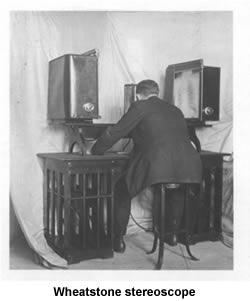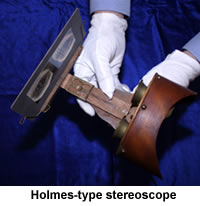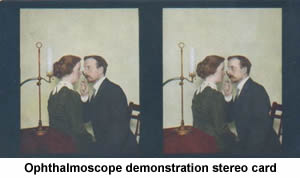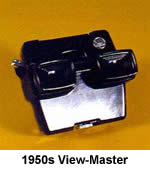This article was featured in Library Notes, #44 (Spring/Summer 2007).
Long before streaming video, iPods and similar late 20th and early 21st century devices, mechanical visual aids were an important part of medical education. Stereoscopic vision was known to the ancient Greeks and can be seen in medieval painting conveying the illusion of depth. The 17th century saw the increased use of similar devices as exemplified in a perspective box invented by Samuel van Hoogstraten (1627-1678).
 Charles Wheatstone (1802-1875), prominent 19th century British physicist, made numerous noteworthy contributions in the field of optics. He revolutionized existing concepts of vision and spatial perception. In his papers “Contributions to the physiology of vision” published in the Philosophical transactions of the Royal Society in 1838 and 1852, he described his studies and experiments developing a theory of stereoscopic vision. He constructed a stereoscope for use with drawings. The development of photography in 1839 furthered the advancement of three-dimensional mechanical devices.
Charles Wheatstone (1802-1875), prominent 19th century British physicist, made numerous noteworthy contributions in the field of optics. He revolutionized existing concepts of vision and spatial perception. In his papers “Contributions to the physiology of vision” published in the Philosophical transactions of the Royal Society in 1838 and 1852, he described his studies and experiments developing a theory of stereoscopic vision. He constructed a stereoscope for use with drawings. The development of photography in 1839 furthered the advancement of three-dimensional mechanical devices.
Single photographs are viewed as two-dimensional. In a stereoscope, two photographs are taken from positions relatively approximated to the position of the viewer’s two eyes and are placed side by side. On observation through the device the two photographs are perceived as a single image, combining the separate images from each eye into a single three-dimensional image.
 In 1849, David Brewster (1781-1868), Scottish inventor and physicist, improved the stereoscope and invented the double camera for taking stereoscopic views. In 1859, Oliver Wendell Holmes (1809-1894), American physician and author, with the aid of Joseph L. Bates, popularized an adaptation of a stereoscope for home entertainment.
In 1849, David Brewster (1781-1868), Scottish inventor and physicist, improved the stereoscope and invented the double camera for taking stereoscopic views. In 1859, Oliver Wendell Holmes (1809-1894), American physician and author, with the aid of Joseph L. Bates, popularized an adaptation of a stereoscope for home entertainment.
 The use of the stereoscope was incorporated into educational curricula in the late 19th and early 20th centuries. The Galter Library has an interesting assortment of sets in anatomy, ophthalmology, radiography and surgical procedures.
The use of the stereoscope was incorporated into educational curricula in the late 19th and early 20th centuries. The Galter Library has an interesting assortment of sets in anatomy, ophthalmology, radiography and surgical procedures.
With the advent of Kodachrome color film, William Gruber of Portland, Oregon, updated the old-fashioned stereoscope with a device he named the "View-Master". It was introduced in 1939 at the New York World’s Fair. Intended for viewing stereo postcards and scenic views, the View-Master became a noteworthy educational tool.
 The paper disks of each View-Master set have 14 color photographs which provide the user with 7 stereoscopic views. The Library has a complete set of a human anatomy atlas.
The paper disks of each View-Master set have 14 color photographs which provide the user with 7 stereoscopic views. The Library has a complete set of a human anatomy atlas.
In the next century, current visual technology will appear as primitive as the stereoscope of the proceeding centuries. While seemingly antiquated, these mechanical visual aids provide a fascinating insight into pedagogical methods of earlier times.
Written by: Ron Sims, MA, Special Collections Librarian.
Please call (312) 503-8133 or email for an appointment with the Special Collections Librarian.
Updated: March 5, 2020